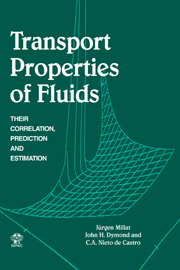Book contents
- Frontmatter
- Contents
- List of contributors
- Foreword
- Part one GENERAL
- Part two THEORY
- Part three DATA REPRESENTATION
- Part four APPLICATION OF SELECTED METHODS
- 9 Computer Calculation
- 10 Modified Hard–Spheres Scheme
- 11 The Corresponding–States Principle: Dilute Gases
- 12 The Corresponding–States Principle: Dense Fluids
- 13 Empirical Estimation
- Part five APPLICATION TO SELECTED SUBSTANCES
- Part six DATA BANKS AND PREDICTION PACKAGES
- Index
13 - Empirical Estimation
Published online by Cambridge University Press: 07 October 2009
- Frontmatter
- Contents
- List of contributors
- Foreword
- Part one GENERAL
- Part two THEORY
- Part three DATA REPRESENTATION
- Part four APPLICATION OF SELECTED METHODS
- 9 Computer Calculation
- 10 Modified Hard–Spheres Scheme
- 11 The Corresponding–States Principle: Dilute Gases
- 12 The Corresponding–States Principle: Dense Fluids
- 13 Empirical Estimation
- Part five APPLICATION TO SELECTED SUBSTANCES
- Part six DATA BANKS AND PREDICTION PACKAGES
- Index
Summary
Introduction
Numerous techniques to estimate transport properties have been published. In this book, there are separate sections that address empirical estimation and corresponding–states methods. Sometimes a method clearly falls into one of these categories, but often the distinction between these categories is not clear–cut, and, in fact, many methods possess both corresponding–states and empirical features. Empirical correlations that lead to tabulations of constants for individual compounds are not presented in this chapter. Rather, those methods that would be considered empirical estimation methods are summarized. Methods to estimate viscosity and thermal conductivities of pure materials are presented first, followed by a discussion of diffusion coefficients. Finally, methods to estimate the viscosity and thermal conductivity of mixtures are discussed. Within each of these five categories, empirical estimation techniques find their greatest application for low–pressure gases and gaseous mixtures. The dense fluid region is generally described by corresponding–states methods. A complete listing of all methods is not given; for more detail, the reader is referred to Reid et al. (1987). There, examples are presented that frequently make the methods easier to use than do the original papers. Methods that have appeared since 1987 are also summarized in this chapter.
Viscosity of pure fluids
Viscosity of pure gases
Three methods are presented by Reid et al. (1987) to estimate the viscosity of a pure gas at low pressure; all require the critical temperature and dipole moment.
- Type
- Chapter
- Information
- Transport Properties of FluidsTheir Correlation, Prediction and Estimation, pp. 296 - 308Publisher: Cambridge University PressPrint publication year: 1996
- 2
- Cited by

